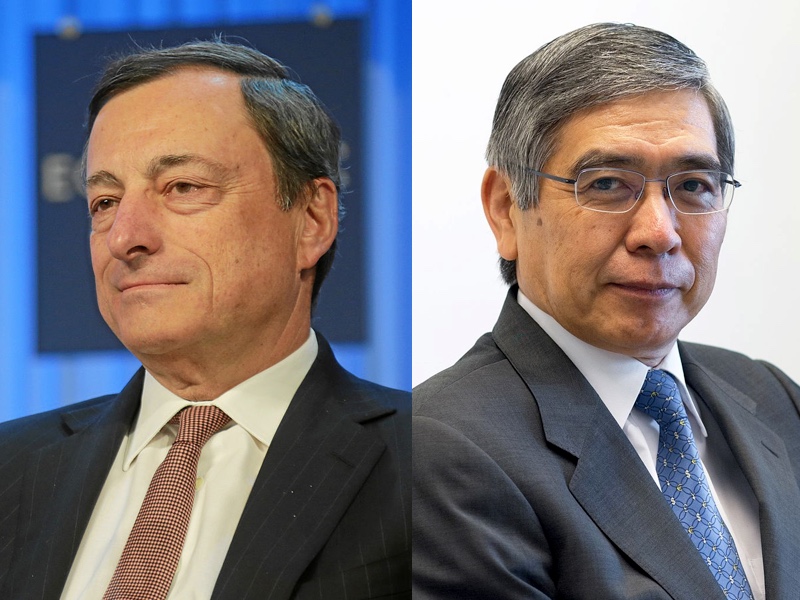The Bad Examples of the ECB and BOJ
Mario Draghi, President of ECB, and Haruhiko Kuroda, Governor of BOJ
Photo Credits: Wikimedia Commons/World Economic Forum and Asian Development Bank
Now there are two central banks living in Alice’s Wonderland! Joining the European Central Bank (ECB) in employing the insanity of negative interest rates is the central bank of Japan, the Bank of Japan (BOJ). Confronted with the fact that their Quantitative Easing (QE) program has been an abject failure in stimulating Japan’s economy, BOJ has decided to levy negative interest rates of minus 0.1% on excess reserves. That is, Japanese banks will have to pay their central bank an interest rate of 0.1% for the privilege of parking their assets in BOJ excess reserves. Excess reserves are the money deposited by commercial banks in the central bank over and above what the central bank requires. The idea is for the central bank to force its member commercial banks to make loans to businesses, stimulating the economy. Now the ECB and the BOJ are together employing both QE and negative interest rates in a “Hail Mary pass” to stimulate their economies.
It is instructive to note these central banks have employed these two policies in opposite order. The ECB began with negative interest rates, imposing a -0.1% rate on excess reserves in June 2014, dropping the rate eventually to -0.3% by December 2015. Not achieving much stimulus with negative interest rates, the ECB added QE to their arsenal starting in March 2015. BOJ adopted these policies in inverse order, starting with QE in its current incarnation in early 2013, and with a lack of stimulative results, they supplemented it with negative interest rates. Also, we have the evidence from the Federal Reserve in the United States that QE is not stimulative at all and is slightly deflationary. The historical experience so far teaches us that QE and negative interest rates, separately and alone, will not stimulate an economy. The ECB and the BOJ are now performing the additional social experiment of employing these policies simultaneously. If I had to bet, I would wager that the policies will prove no more successful together than they were separately.
Why should this be? Both policies are supposed to work by encouraging banks to lend money to companies and individuals to stimulate demand and investments in productive capacity. But what happens if companies find the economic environment so hostile they can not find productive ways of investing borrowed capital? Instead of investing in new productive capacity, we have seen how companies tend instead to buy back their stock to bolster their PEs, to pay dividends to their stockholders, and to acquire other companies. Companies then go into debt for reasons other than to increase productive capacity and create jobs. The primary effect of new bank loans in such situations is to inflate asset bubbles. The old metaphor from the 1930s of “pushing on a limp string”, often attributed to John Maynard Keynes, seems apropos.
Contemplating this sad spectacle, one sees the connection to the current attempt by Keynesians to revive their old doctrine of Secular Stagnation. The fundamental ideas of this doctrine are that firms can not find productive ways to invest capital due to lack of demand from markets, and therefore the government is the only entity left that can stimulate demand over a long period of time. There is little appreciation for the chaotic nature of an economic system in this Keynesian picture. Because of the “butterfly effect” in these systems, i.e. for very small system changes to create very large disturbances later on, global economic changes instituted by a government can create many unintended and undesirable side effects. Here is where the microeconomics of neoclassical economic theory provides a better policy prescription. Rather than relying on all-encompassing, macroeconomic solutions for slow or nonexistent growth, a chaotic economy responds better to a multitude of local solutions by economic agents closest to their problems, as I discussed in How to Solve Problems in Chaotic Social Systems.
In order to entice companies to invest in new capacity, a country’s government would have to ensure the economic environment encourages growth. To do this in a chaotic system, the freedom and capability of local economic agents most exposed to and knowledgable of their particular problems must be buttressed. Ham-fisted governments trying to affect the entire economy at once, or a large fraction of it, could create as many problems as it solved. With the current statist policies of Europe, Japan, and the United States, this is precisely what is not provided by governments in most if not all of the developed world. Certainly, trying to solve slow economic growth with the clumsy blunderbuss of monetary policy is using the wrong tool for the job. Instead, government actions that give local agents more resources through tax cuts and freedom to address their problems through reduction of government regulation would be more assured of success. As it turns out, we have actual empirical evidence that this is the case, as discussed in the post The Rahn Curve, Hauser’s Law, the Laffer Curve and Flat Taxes.
In the end, trying to escape a repeat of the bad examples of the ECB, the BOJ, and the Federal Reserve is a political problem. More precisely, it is a problem of persuading the electorate that direct government action on the economy, apart from tax cuts and a reduction of government regulations, is harmful. Monetary policy is best used to maintain a constant value of money, not to stimulate economic growth. In an era where millennials and the Democratic Party are becoming more enamored with socialism, this is a tall order.
Views: 3,404





























